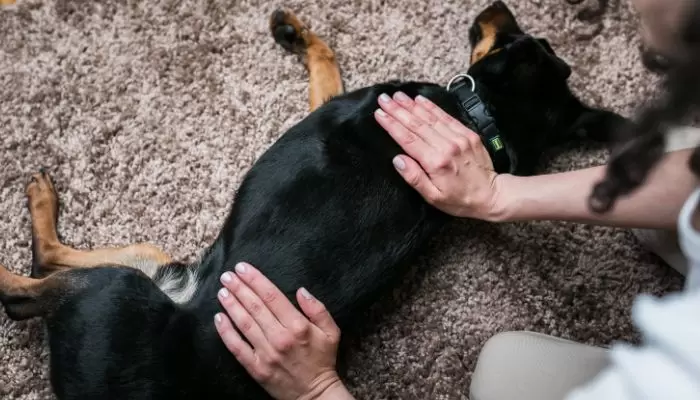
Table of Contents
Cryptorchidism in Dogs
Many people have heard of the term “cryptorchidism.” But, did you know that this condition also affects your dog? If you want to learn more about what cryptorchidism in dogs looks like, then keep reading below.
In humans, cryptorchidism occurs when a baby boy’s testicles fail to descend into his scrotum. This means that he will never be able to produce sperm, and so, the condition can lead to infertility. However, it’s important to note that many boys with this condition can still father children later in life.
Cryptorchidism in dogs is very similar to the human version. In fact, some breeds of dogs are prone to having their testicles hang outside the body. The problem arises when these puppies grow up and try to mate. As a result, they may end up producing infertile offspring.
Related: Testicle Drop Naturally
So, what does this mean for your dog? Well, if you’re worried about whether or not your pet is going to be able to reproduce, then you should take him to the vet. Your veterinarian will need to perform an examination to determine if there are any problems. Once that has been done, it will help them to figure out how best to treat your canine companion.
Causes of Cryptorchidism in Dogs
Cryptorchidism is an extremely rare condition that affects both male and female puppies. The cause of the problem varies from puppy to pup, but it usually happens when the testicles don’t descend into their correct position within the body.
Here are some reasons why your dog might be affected by this disorder:
Congenital malformations or birth defects Unexplained medical conditions Infection Trauma Affected dogs can have one or both testicles affected by cryptorchidism. It usually occurs in a single testicle, but sometimes both testicles are affected.
The symptoms of cryptorchidism vary depending on the age of the dog and the location of the testicles. Young puppies and pups that have not yet had their first growth spurt can be affected by a mild form of cryptorchidism.
This is known as a “prepubescent” cryptorchidism. When the first growth spurt occurs, these young dogs will begin to develop secondary sex characteristics such as nipples, and may also become sexually mature.
This is called an “adolescent” cryptorchidism. In this case, the testicles are not found in the correct place within the abdomen. If this occurs during the prepubescent stage, the testicle will develop a “milder” form of cryptorchidism.
If the testicles do not descend into the scrotum by the time they are 3 years old, they will not develop properly. They can be surgically relocated or surgically moved to the correct position.
The surgery usually involves creating a small incision and moving the testicles down to the scrotum through this incision.
Some dogs have a condition called “congenital inguinal hernia.” This is when the abdominal wall does not close correctly over the testicles. Congenital inguinal hernia is usually corrected with surgery.
What is Cryptorchidism in Dogs?
Cryptorchidism is a condition where one or both testicles fail to descend into the scrotum, which can lead to infertility, infection, or other complications.
What is cryptorchidism?
“Cryptorchidism is a condition where one or both testicles fail to descend into the scrotum, which can lead to infertility, infection, or other complications.” Cryptorchidism is a congenital malformation that occurs in 1 in 1000 dogs. It is caused by an abnormal development of the genital tubercle, which is the first part of the urogenital tract that develops in the embryo.
The affected dog will have a normal appearance at birth, but it may not have descended testicles. The most common symptoms of cryptorchidism are a drooping penis, lack of a penis erection, and inability to urinate.
Other symptoms include a lack of sperm production and an inability to impregnate females. A veterinarian can diagnose this condition with a simple physical exam and a rectal temperature check.
If the testicles of dogs aren’t in the scrotum, where are they?
They are actually hanging down from the abdominal cavity.
What’s more, they have no connection with the peritoneal cavity. It is just like your head and neck, which are also suspended from the abdominal cavity.
So if you look at it from that angle, the testicles are really not part of the abdominal cavity. If you think about it in this way, it makes sense why they need to be so close to the body core.
They don’t have to carry a lot of weight. The abdominal cavity is very elastic, and the muscles there can stretch.
How is cryptorchidism diagnosed in dogs?
Step 1: Check your dog for signs of a urinary tract infection: If you notice that your dog has a discharge from his penis, he may have a urinary tract infection.
Urinary tract infections are common in puppies, so you should check your puppy’s urine to make sure it’s clear. If you find that your puppy has a urinary tract infection, you can treat it with an antibiotic.
Step 2: Check your dog’s testicles: If you notice that your dog’s testicles are swollen, you should take him to the veterinarian.
If you don’t see anything abnormal with your dog’s testicles, you can wait and watch. If your dog’s testicles are not in the scrotum, they may be underdeveloped.
Step 3: Perform a rectal exam: You can perform a rectal exam to check for cryptorchidism. If you can’t feel your dog’s testicles in his scrotum, you can perform a rectal exam.
Step 4: Check your dog’s scrotum: If you can’t feel your dog’s testicles in his scrotum, you can perform a rectal exam. If you still can’t find your dog’s testicles, he may have a hernia.
What causes cryptorchidism and how common is it?
Cryptorchidism is a condition where one or both testicles do not descend into the scrotum during fetal development. It affects approximately 1 in 500 males, with an incidence of 1 in 1000 births.
What are the signs of cryptorchidism?
Cryptorchidism is a condition where one or more testicles remain in the inguinal canal and fail to descend into the scrotum. The most common cause of cryptorchidism is a blockage in the ducts that carry the testicular fluid.
What is the treatment for cryptorchidism?
Cryptorchidism is a birth defect that prevents the testicles from descending into the scrotum. It can be present at birth or develop later. The condition can cause problems during urination, sexual function, and fertility.
There are two main types of cryptorchidism: congenital and acquired. The congenital type occurs at birth and is present at birth. It may not be noticed until after the child reaches puberty. The acquired type appears later and is usually caused by an injury to the genital area.
The most common treatment for cryptorchidism is surgery. Surgery to remove the undescended testicle is performed when the condition is diagnosed before the age of 2. Surgical removal of the undescended testicle is called orchiopexy. Surgery to repair a damaged scrotum is called orchidopexy.
What is the prognosis for a dog with cryptorchidism?
The prognosis is not good. Dogs who are born with this condition are often infertile, and if they are not removed surgically, they may have health problems later in life.
How Do Vets Diagnose Cryptorchidism in Dogs?
Veterinarians can diagnose cryptorchidism in dogs by examining the testicles. They will be able to tell if there is a problem because the testicles should be able to be felt.
Cost of Surgery for Cryptorchidism in Dogs
The average cost of surgery for cryptorchidism in dogs is $500. This cost includes the anesthesia, surgery, and post-operative care.
WHat is Retained Testicle (cryptorchidism) in Dogs
If a dog has been castrated, its sex organs will be covered with a layer of skin. However, in some cases the scrotum may remain uncovered. This condition is called ‘retained testicle’.
What Causes Cryptorchidism?
In many cases, this is due to a lack of hormones. Normally, a boy will begin producing testosterone during puberty.
After he reaches sexual maturity, his body starts to produce estrogen and progesterone. These two hormones are important for stimulating the development of secondary sex characteristics.
When there isn’t enough hormone production, the dog’s genitals don’t develop properly. The result is that a dog’s testes never descend into the abdominal cavity.
In addition, the urogenital sinus doesn’t close off. This means that urine passes through the penis instead of being stored in the bladder.
